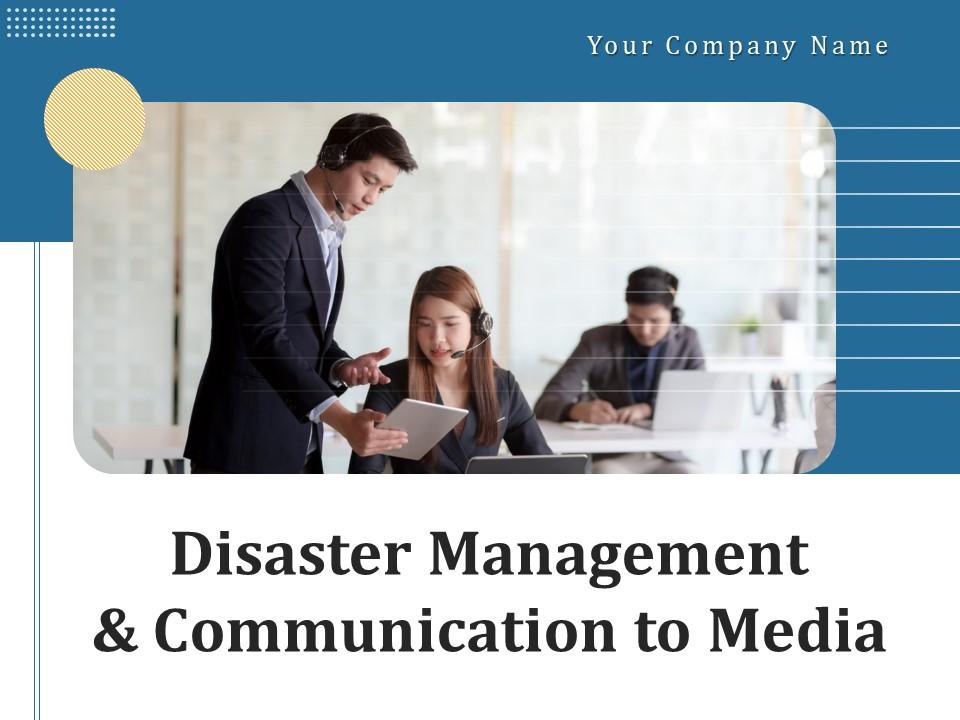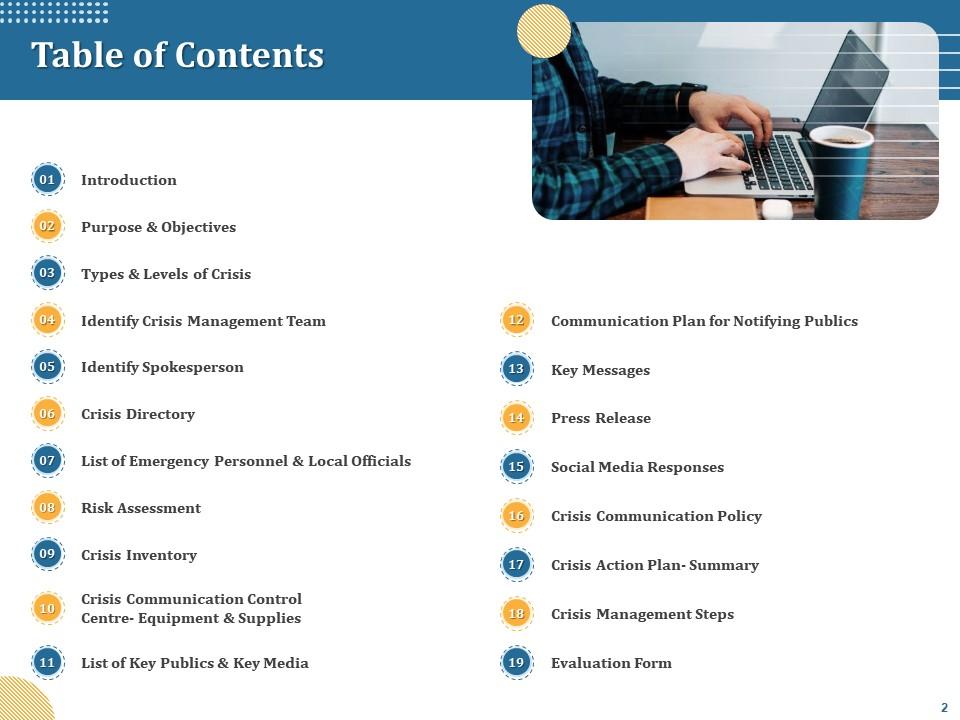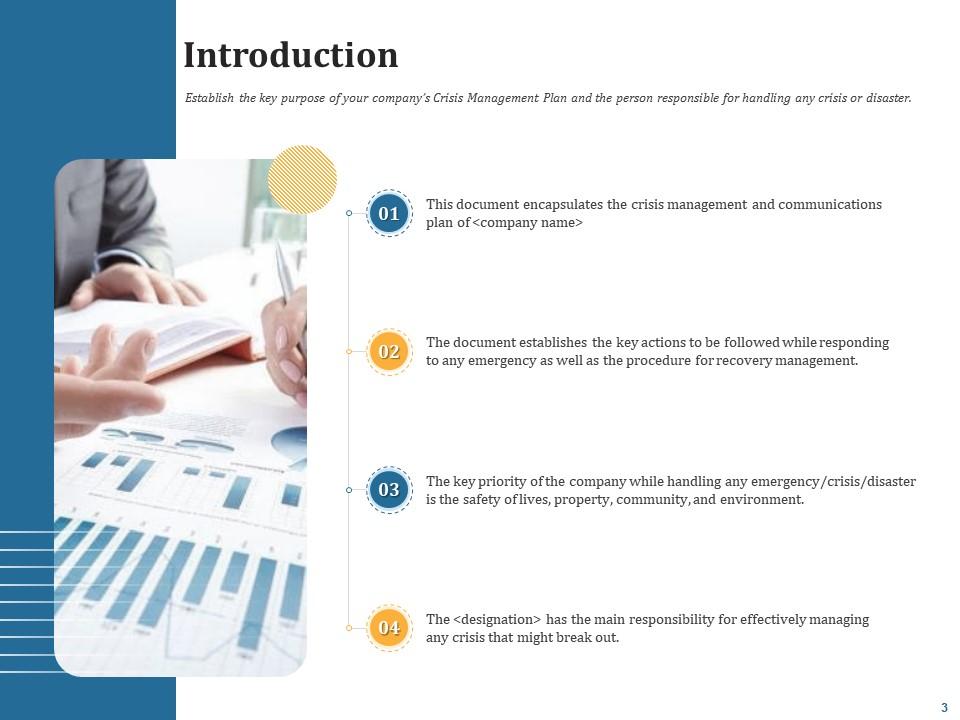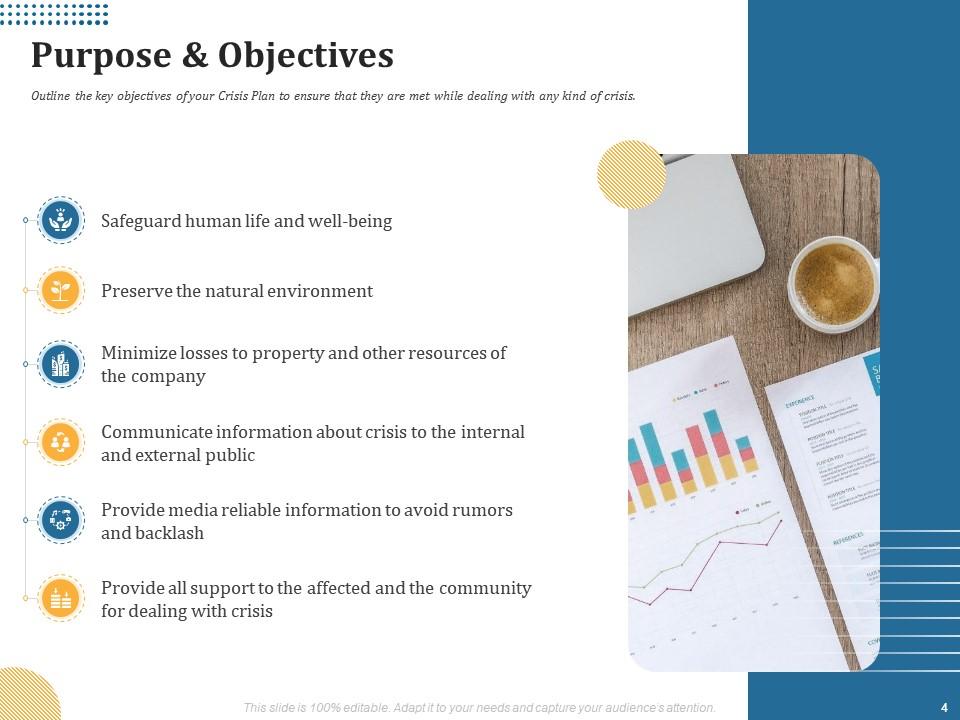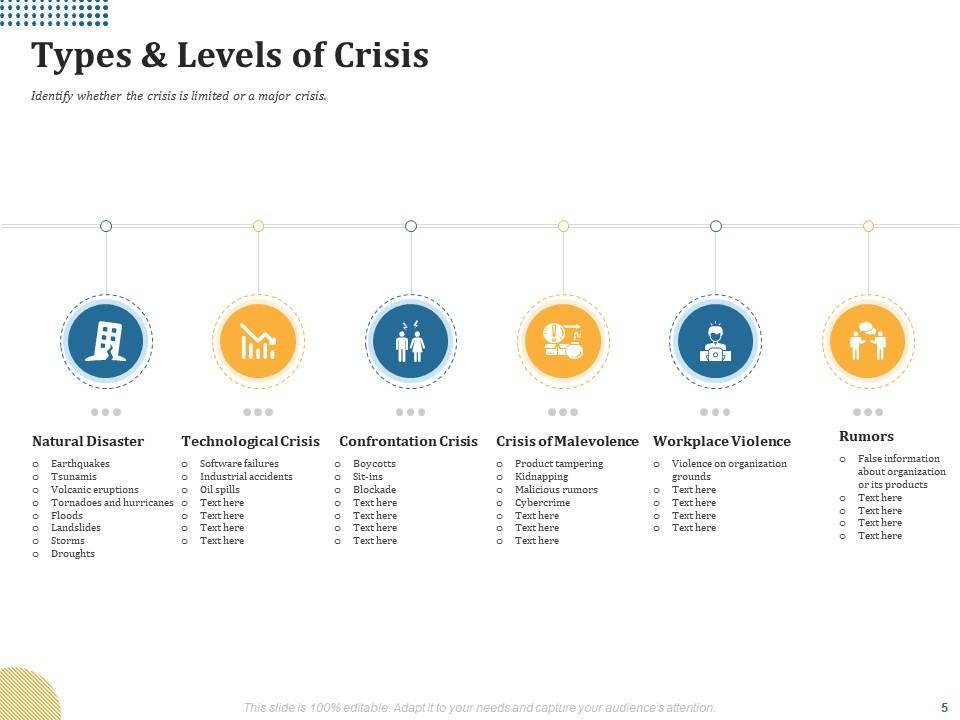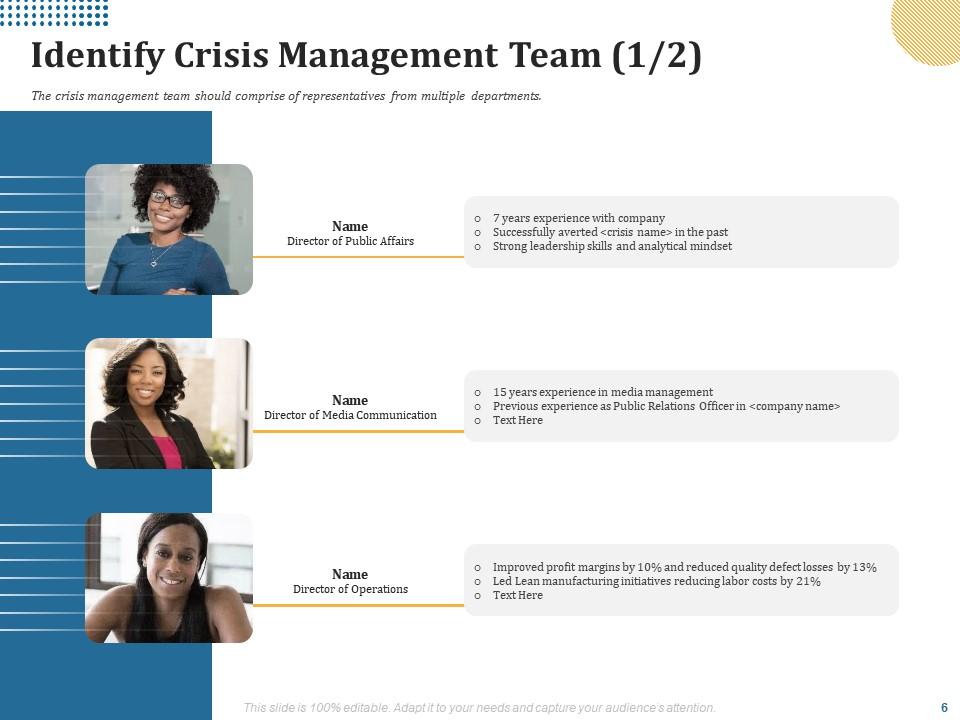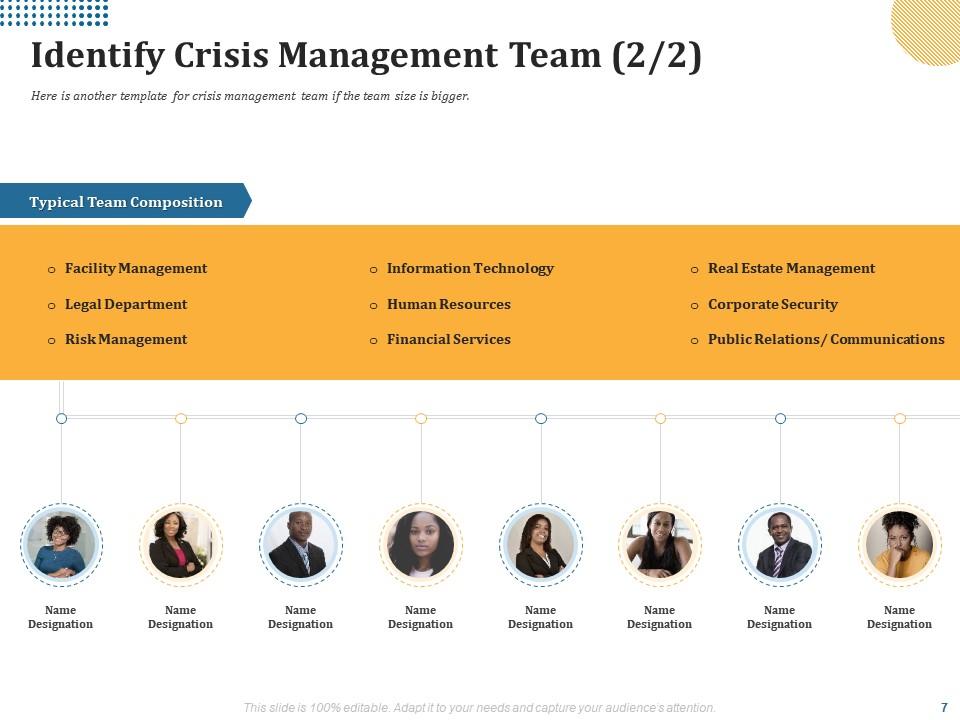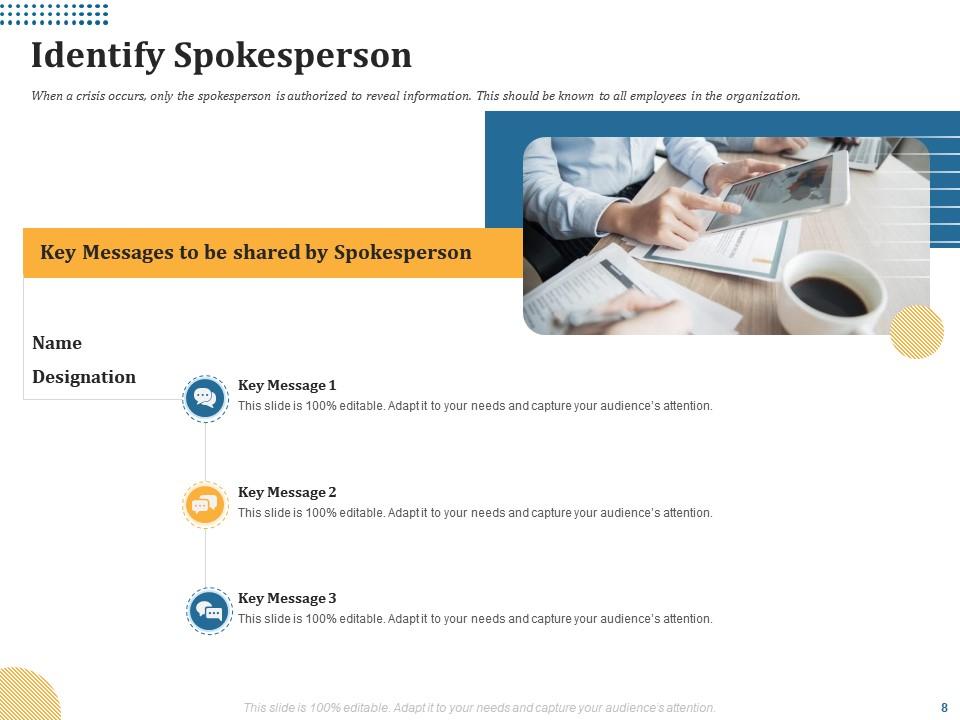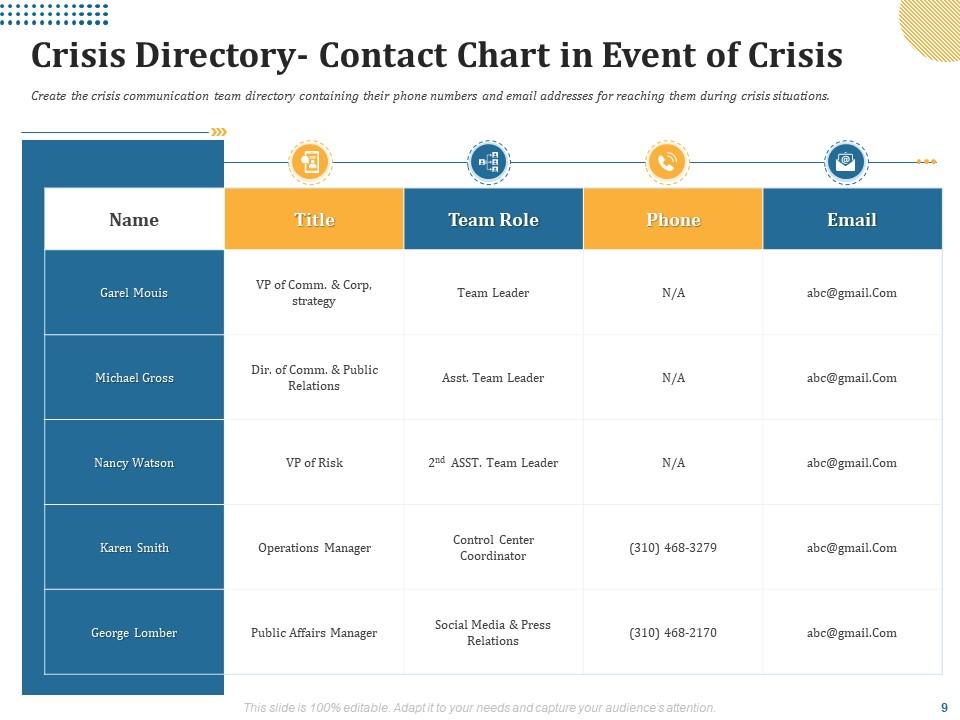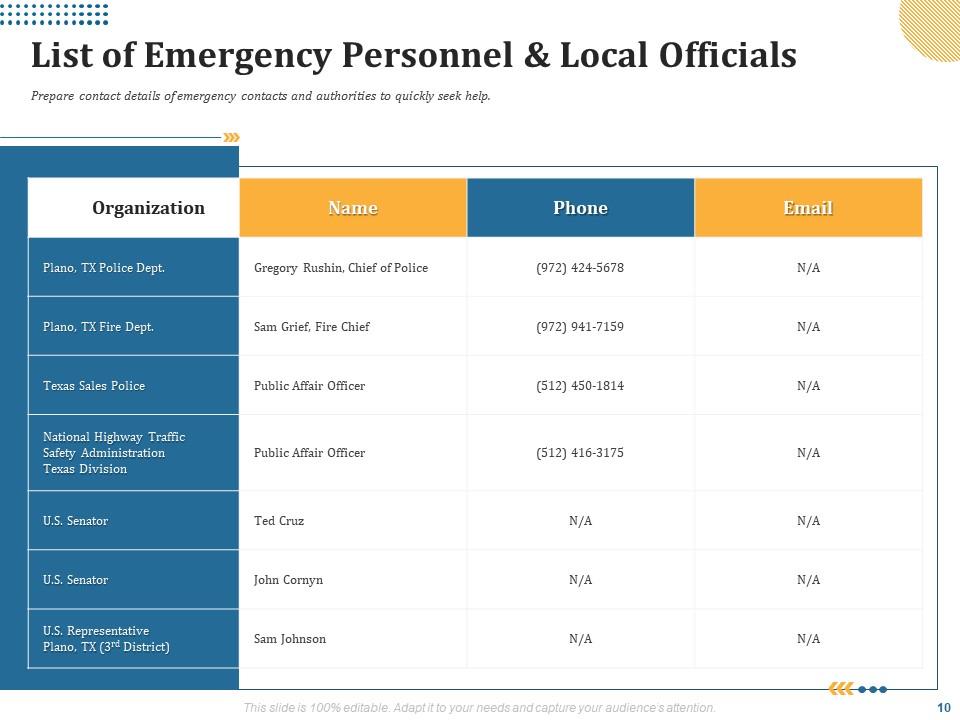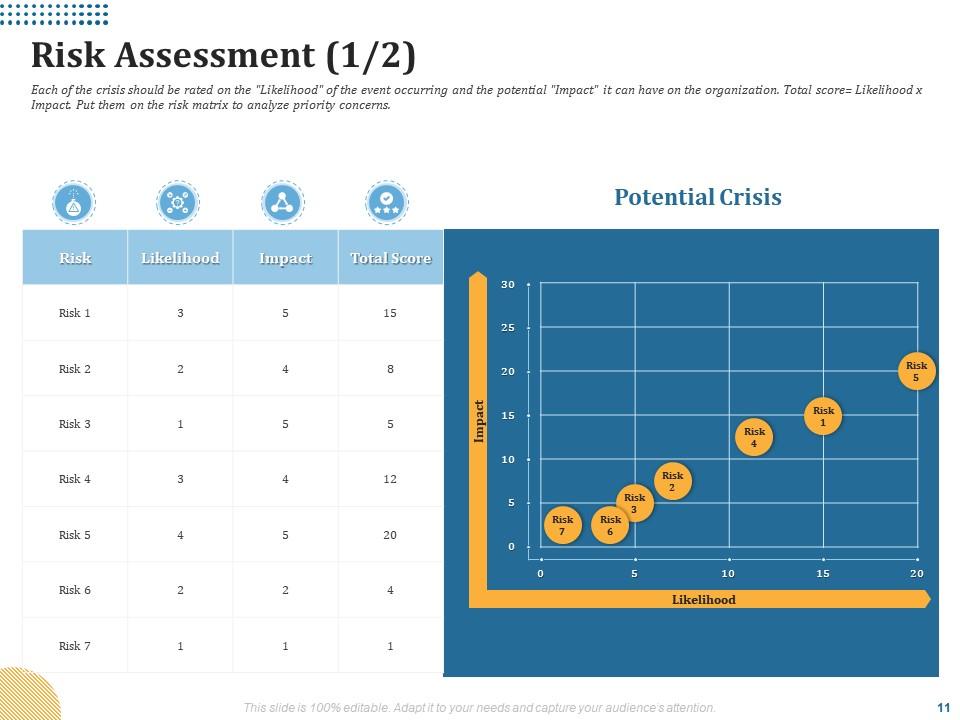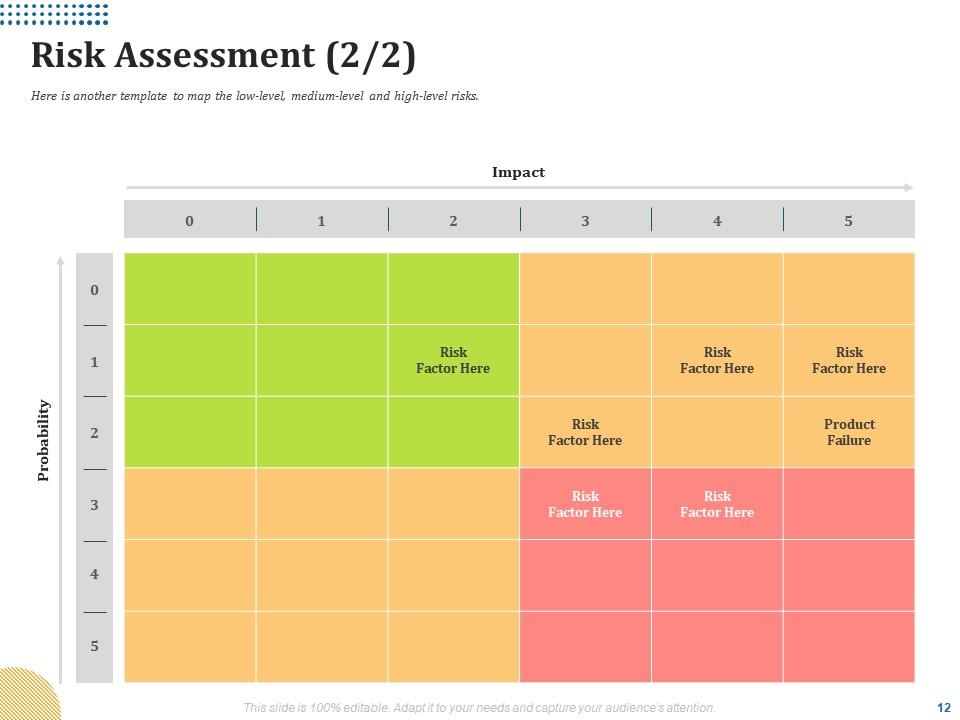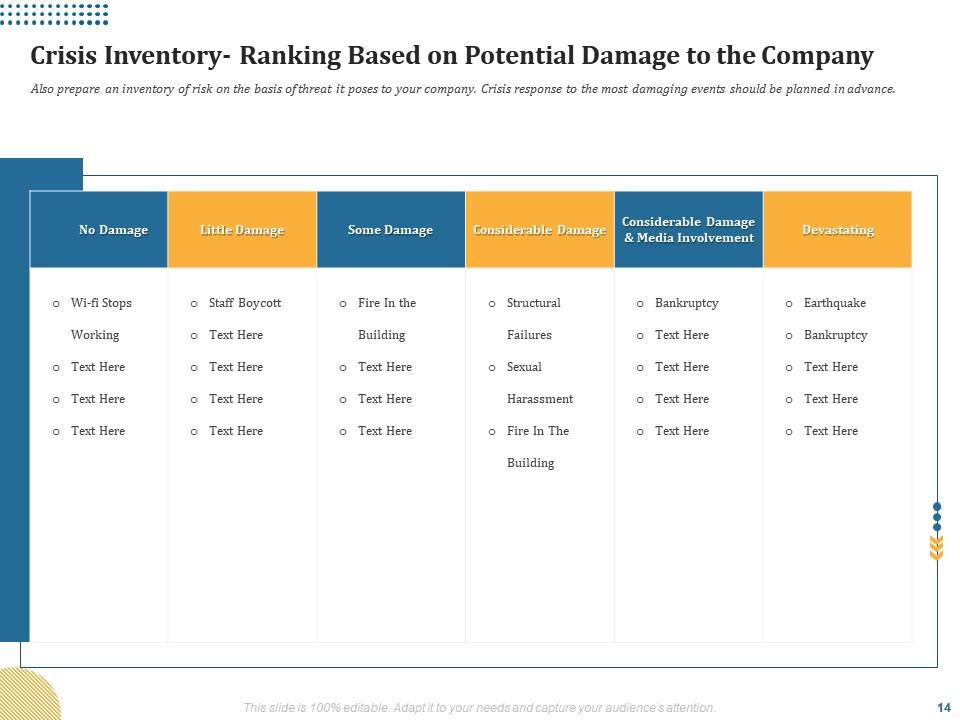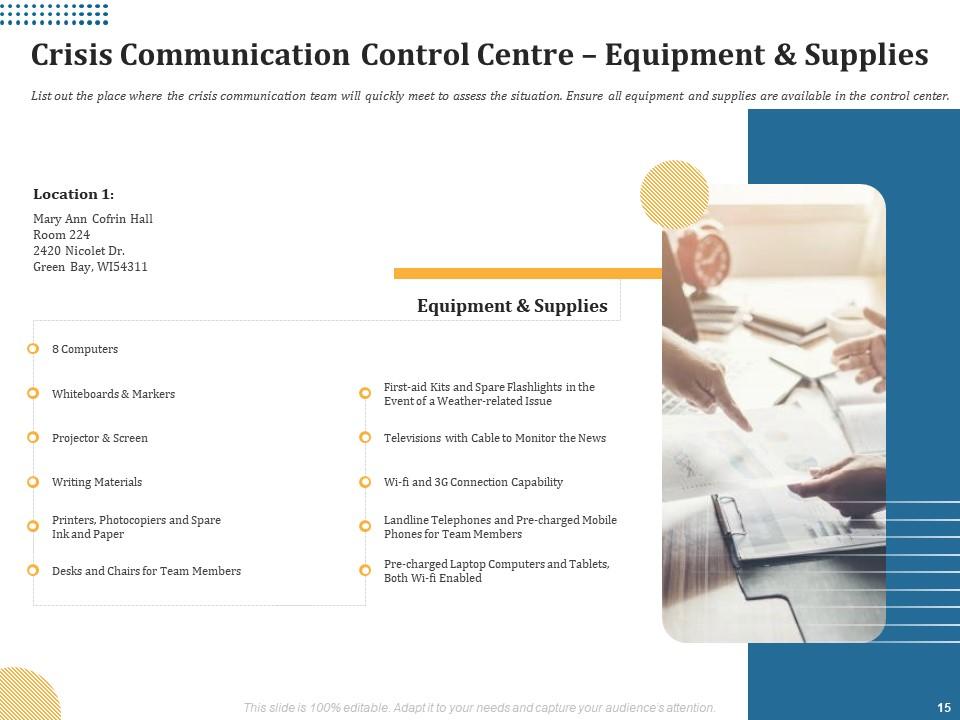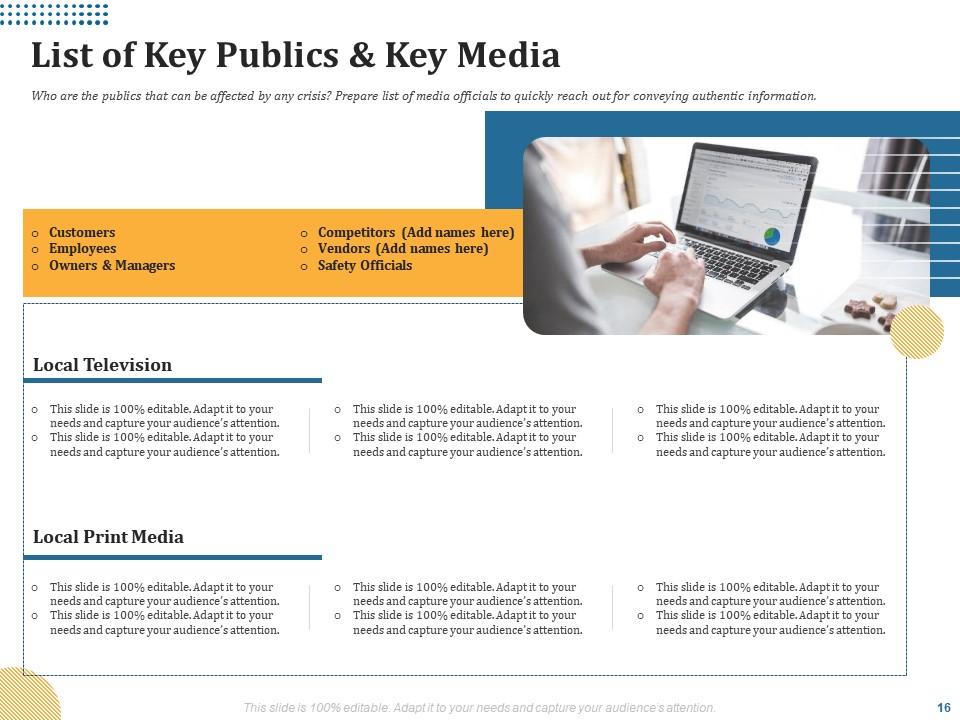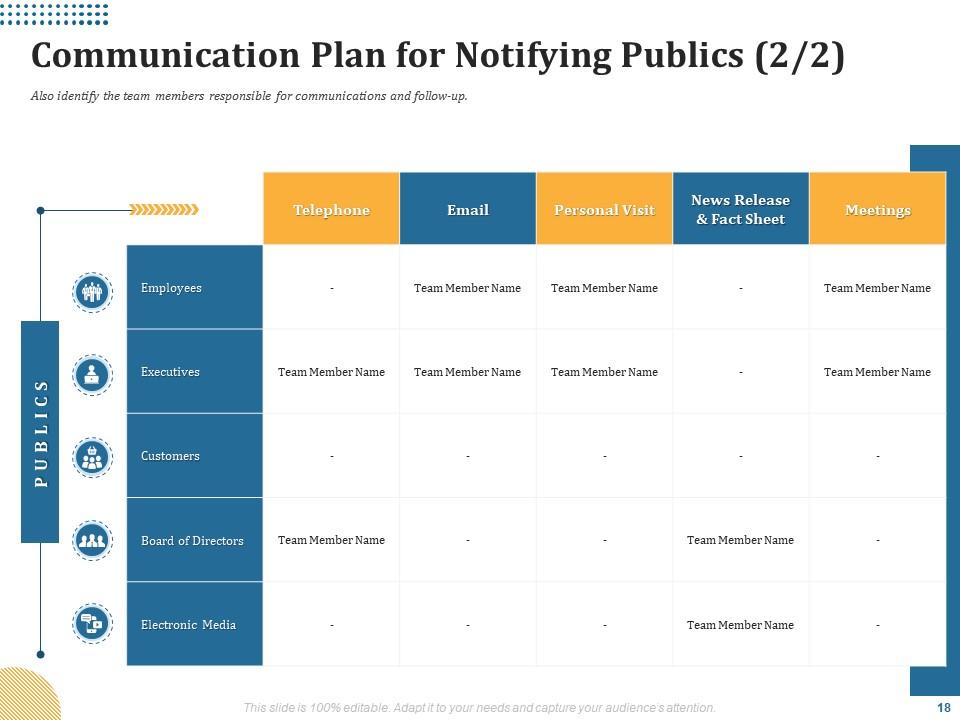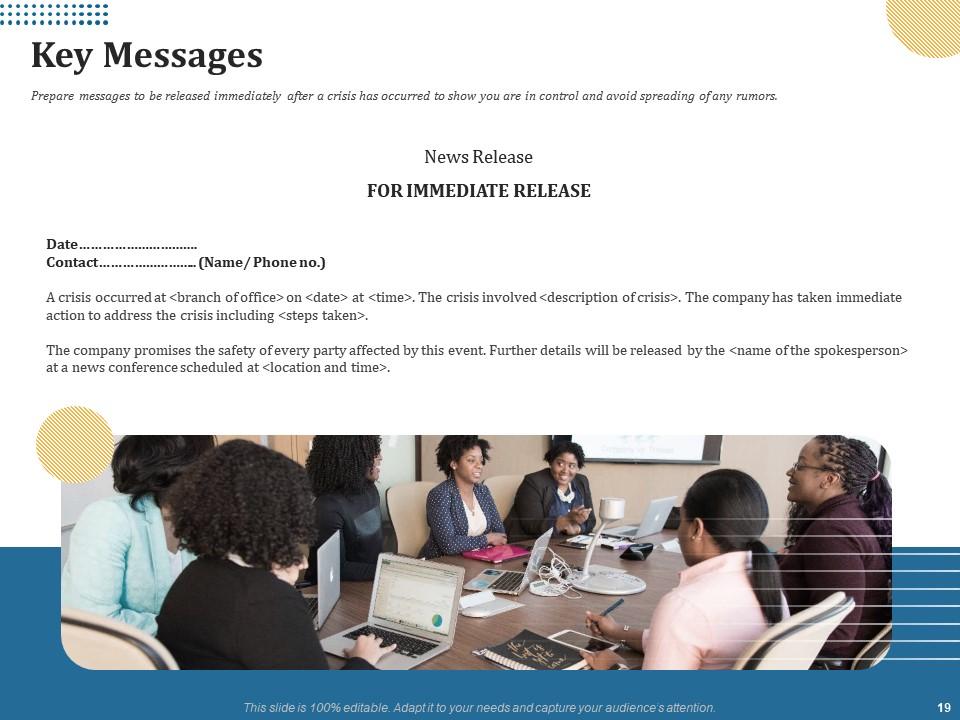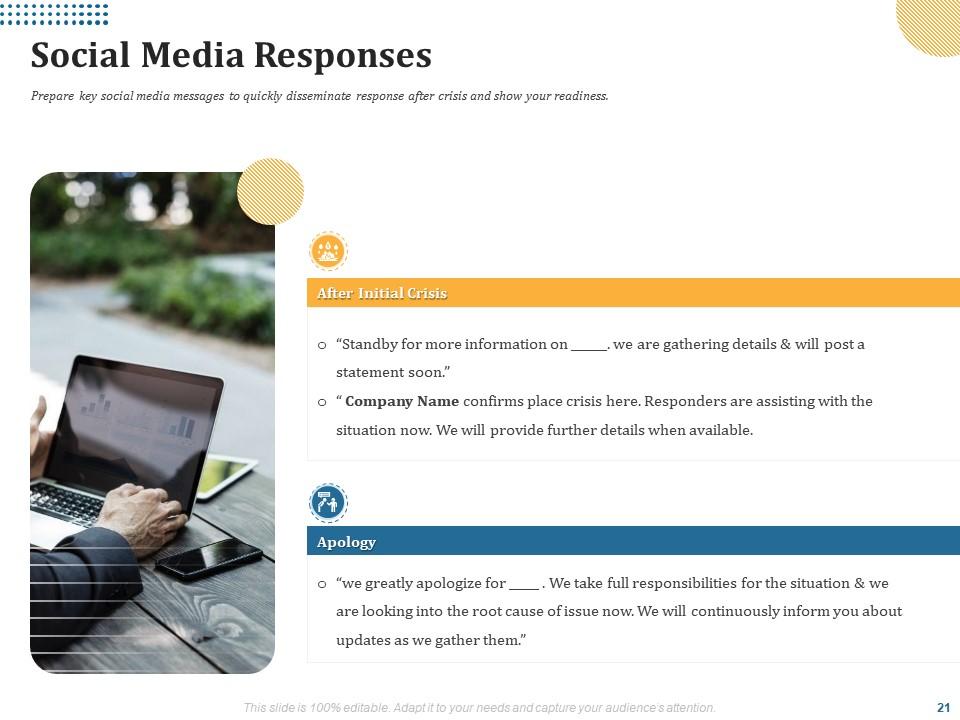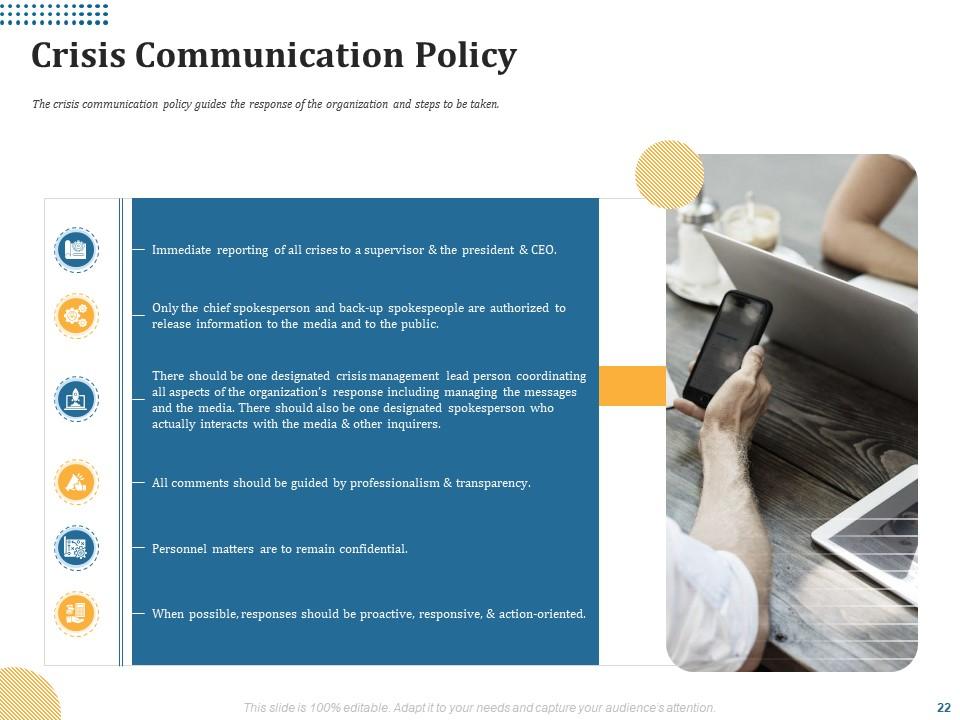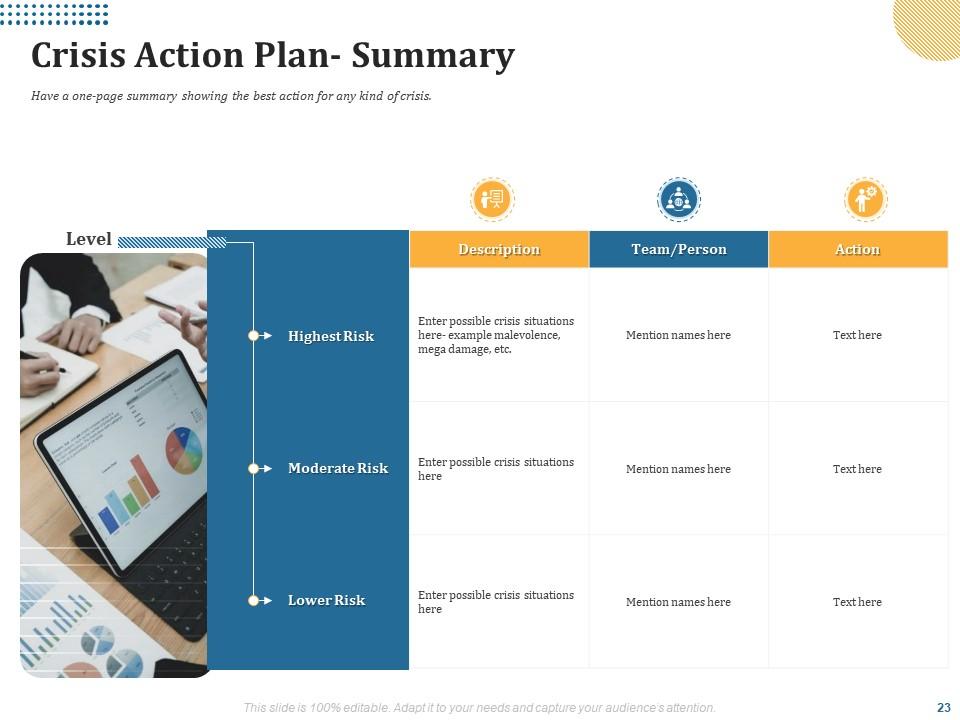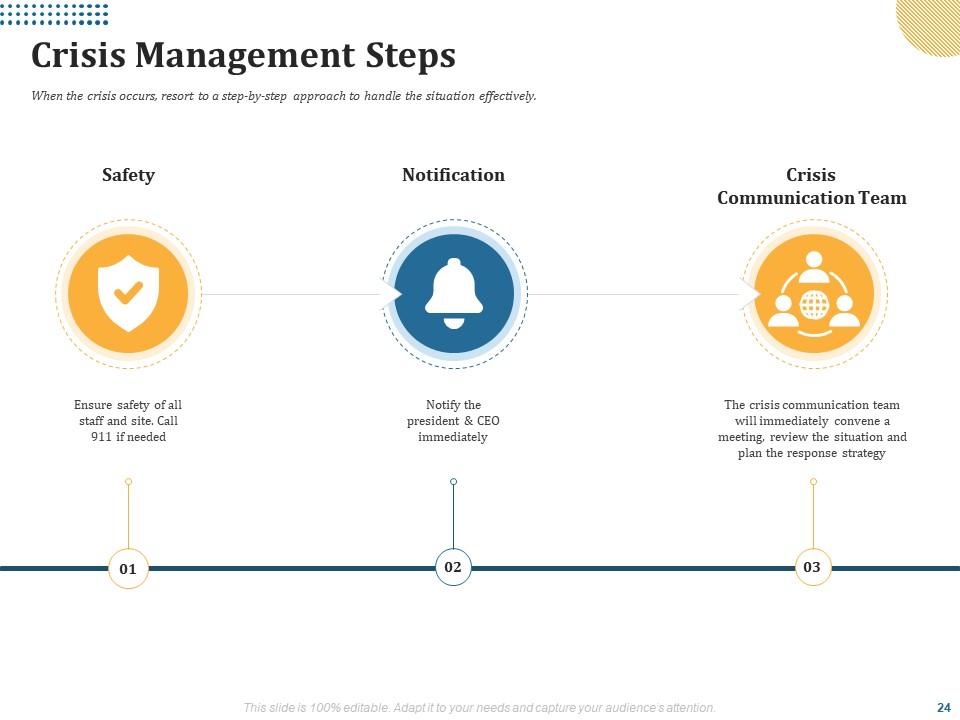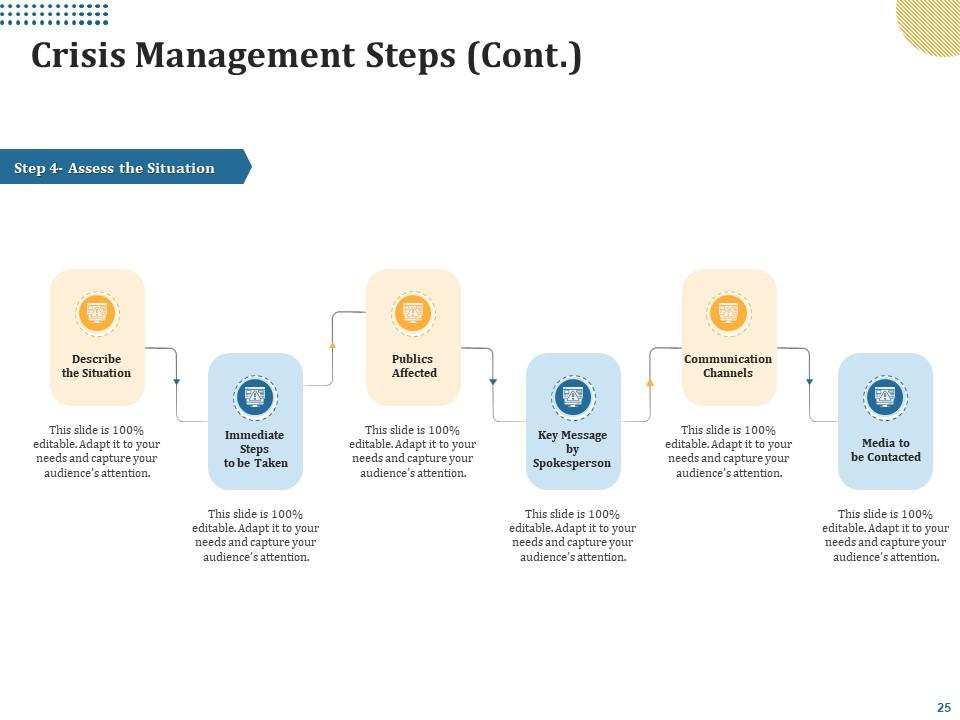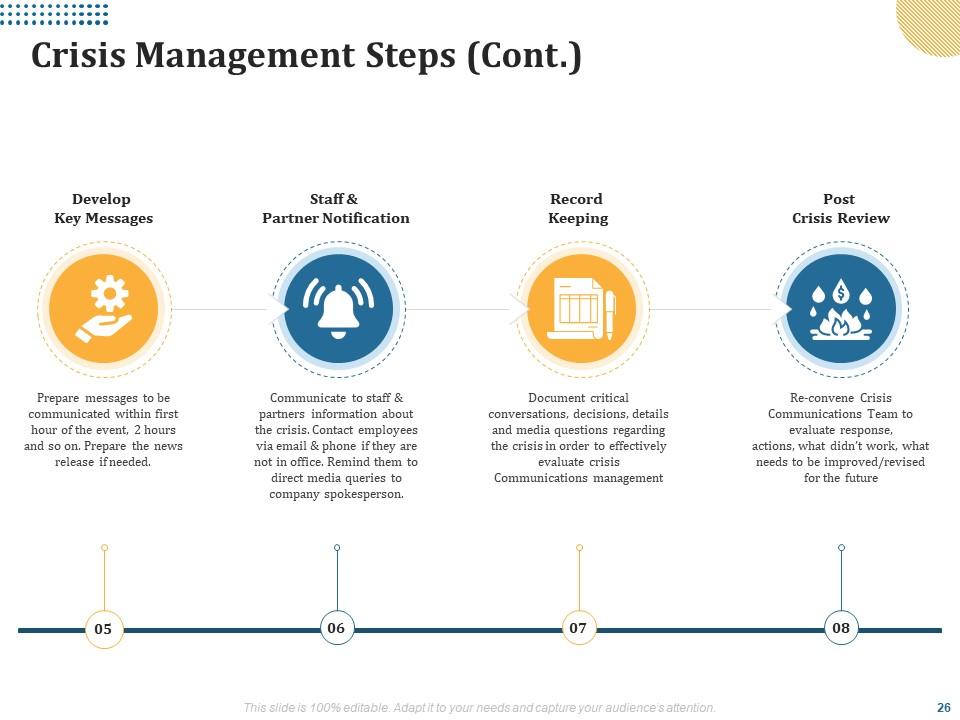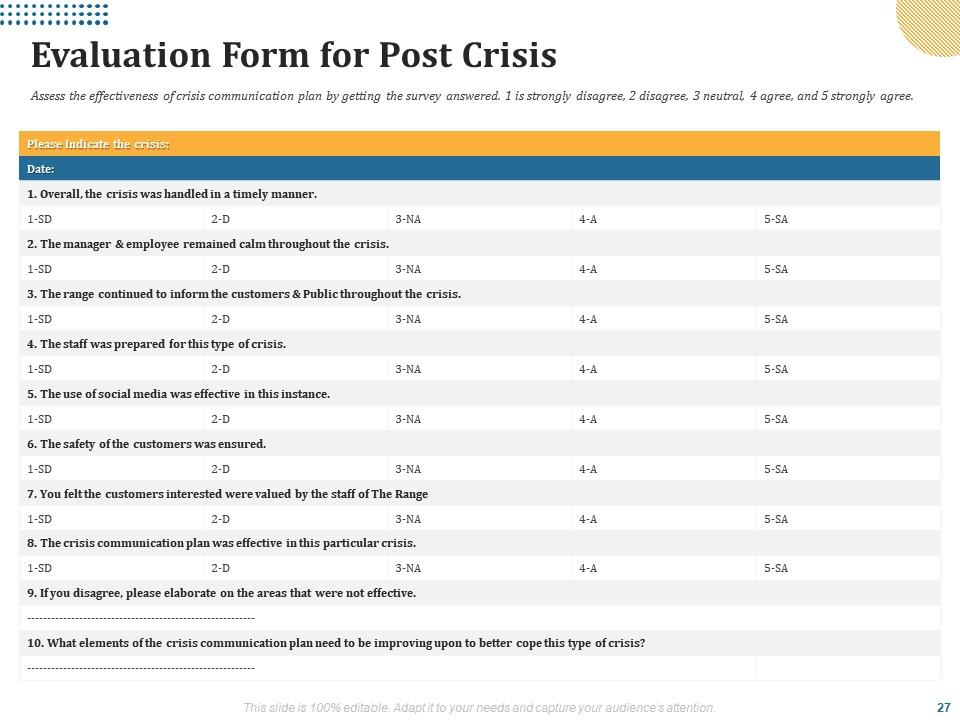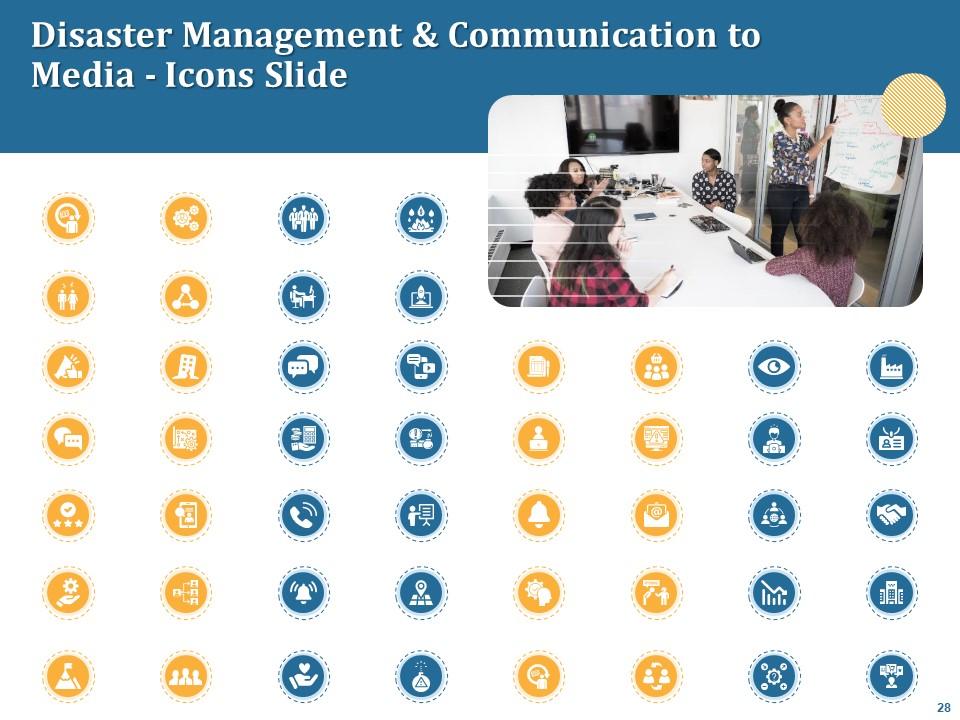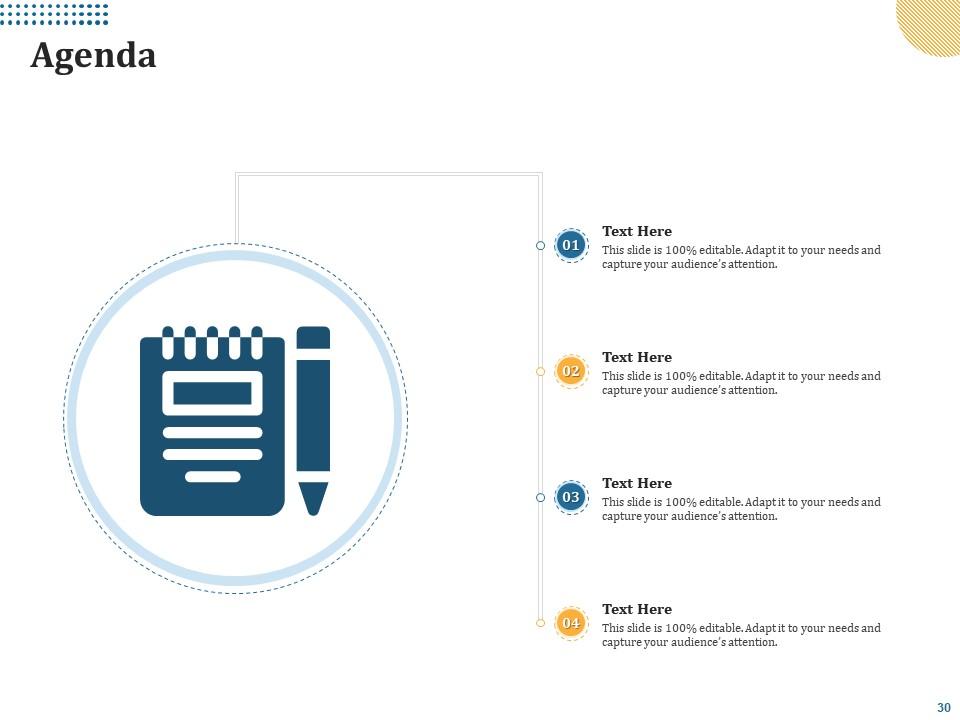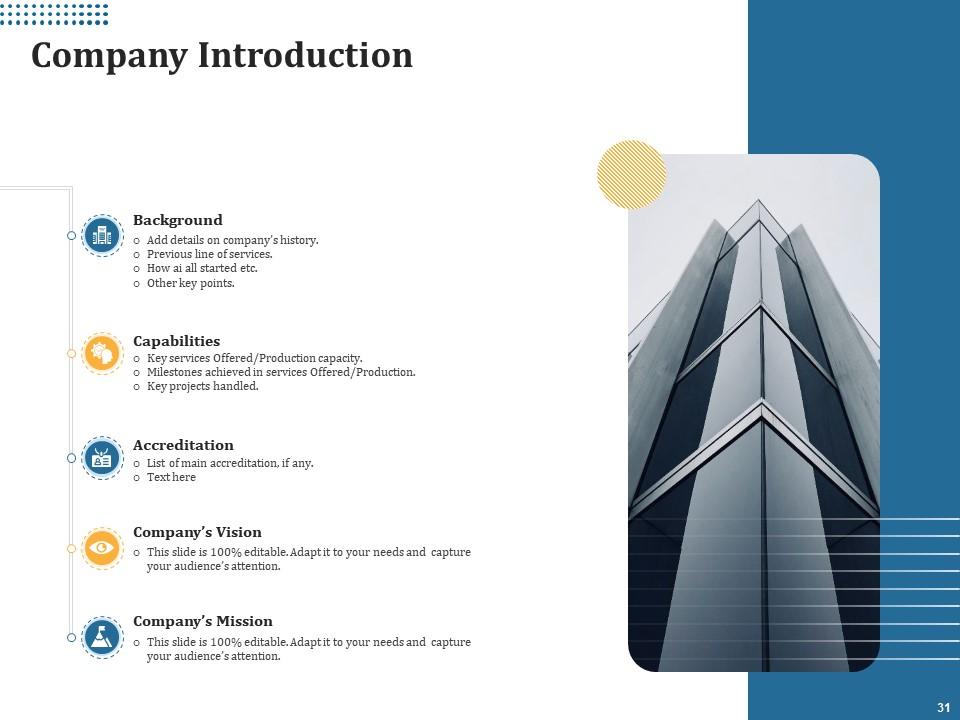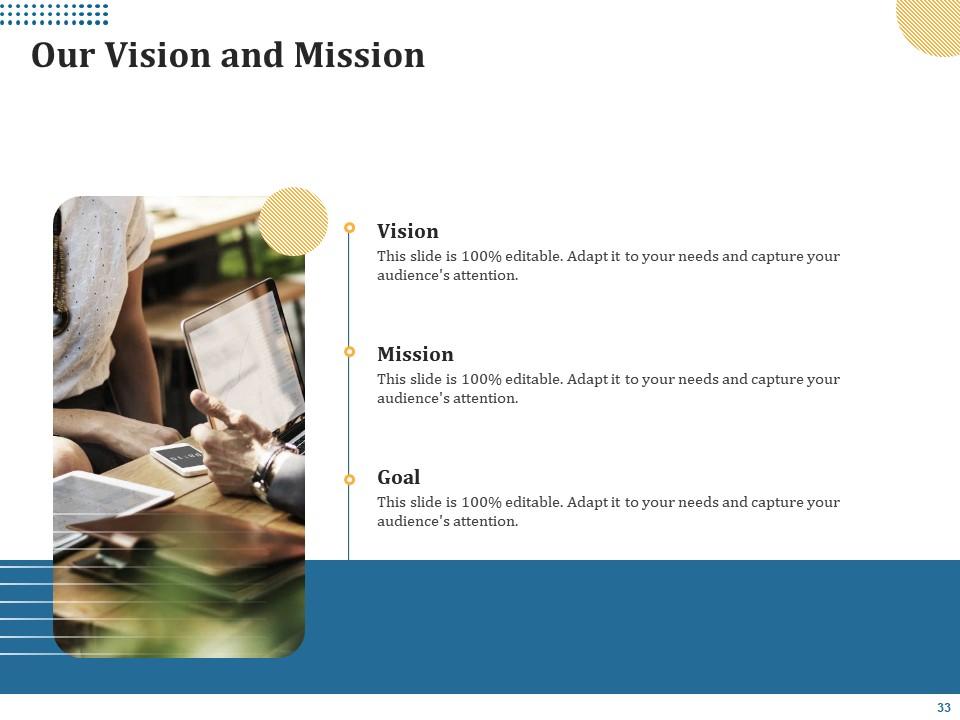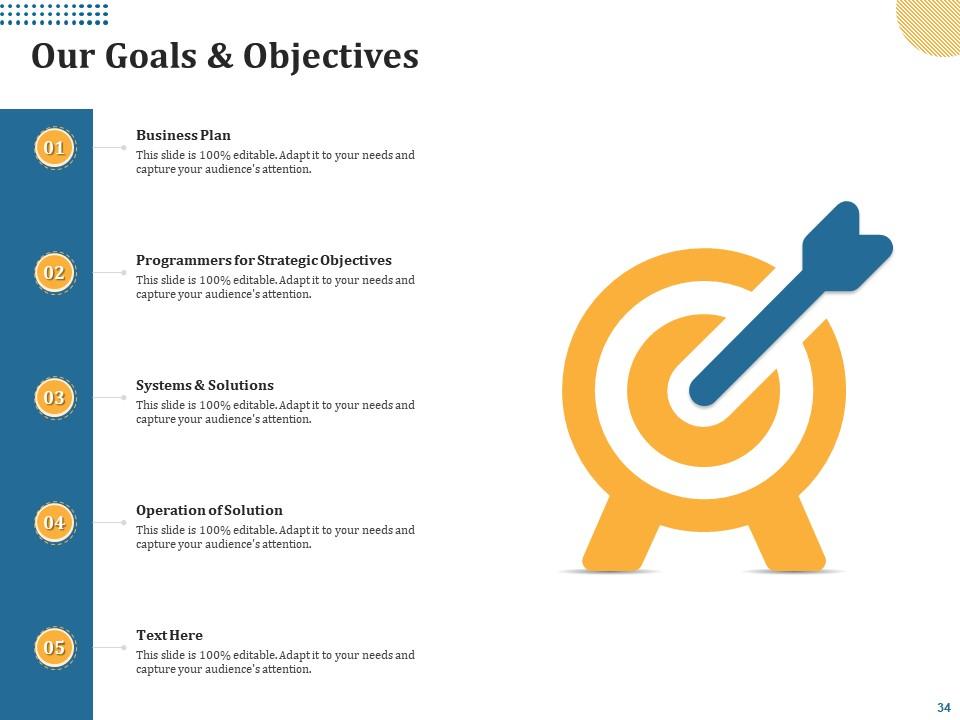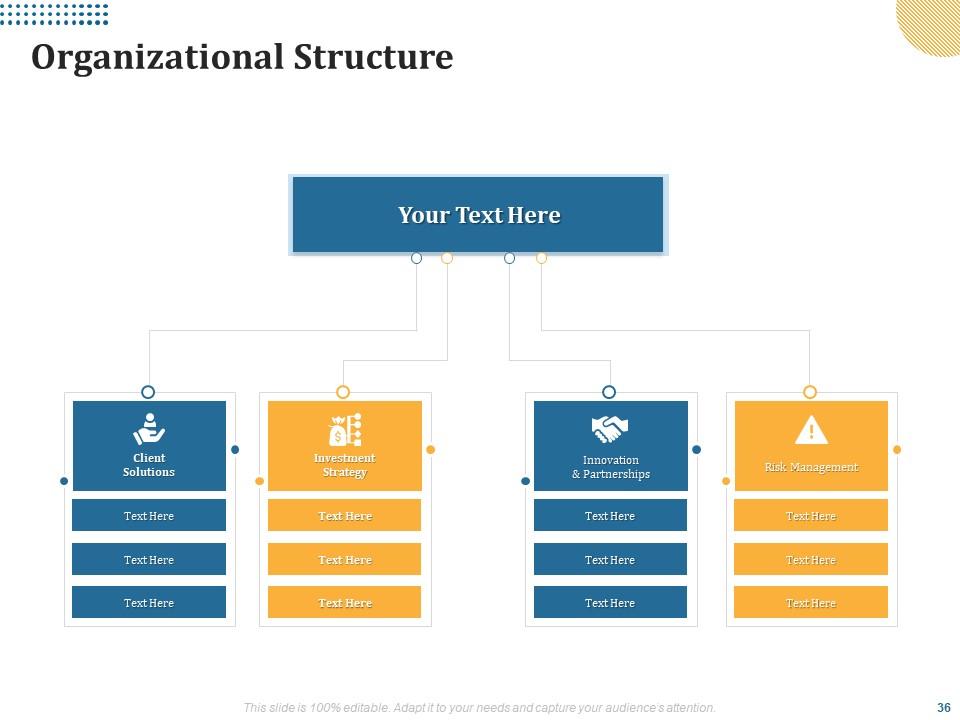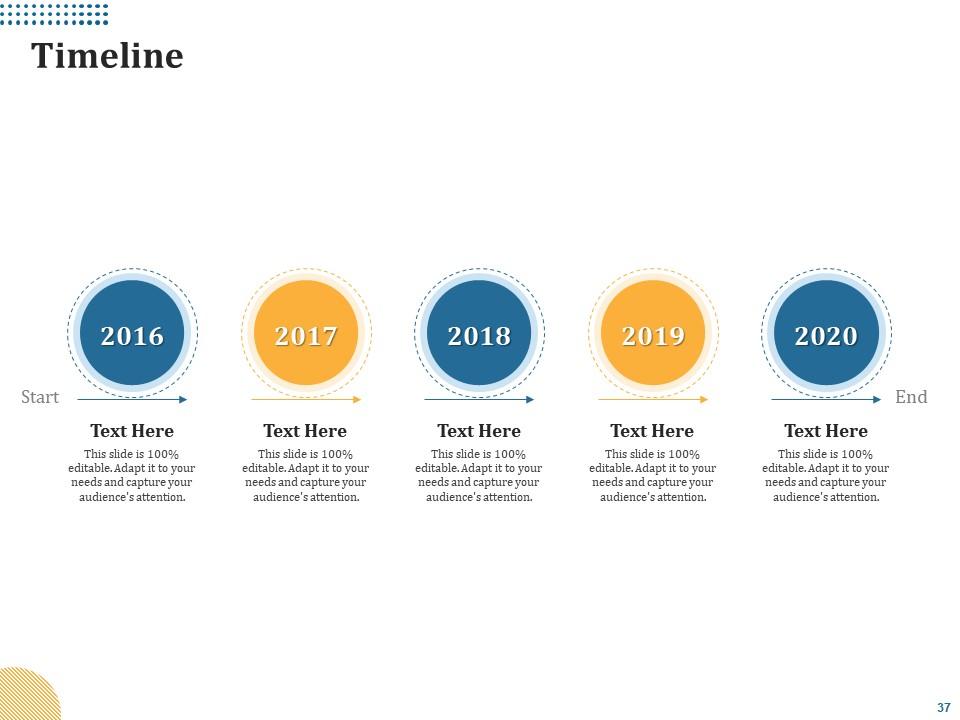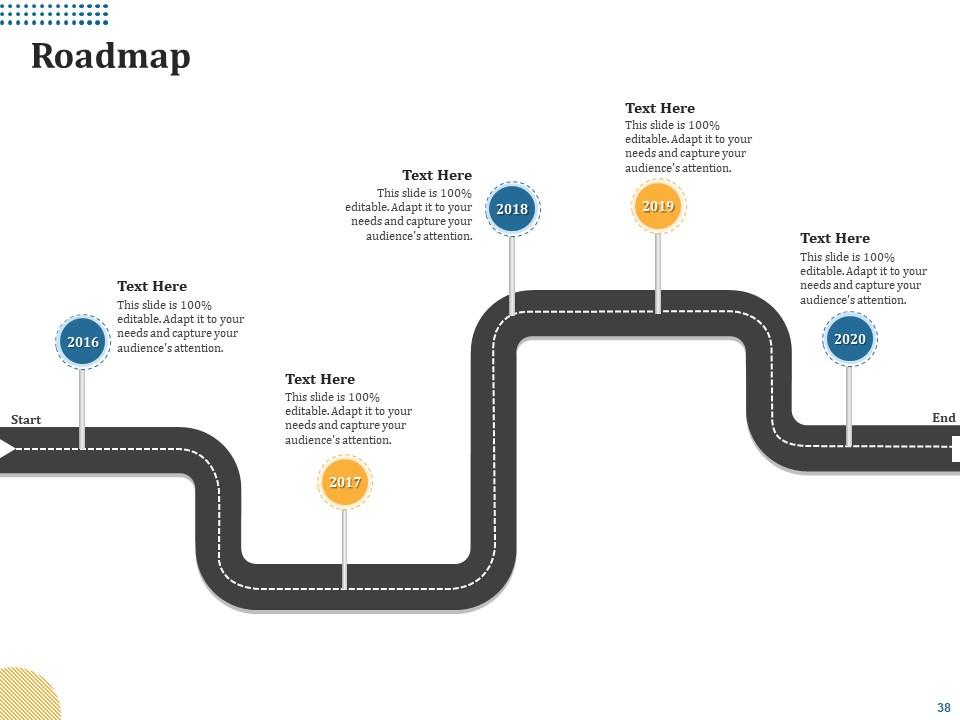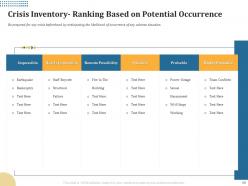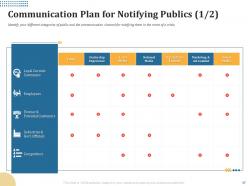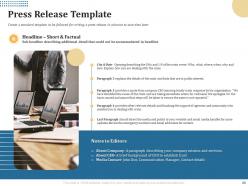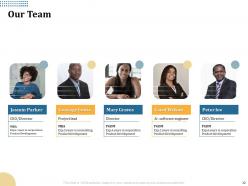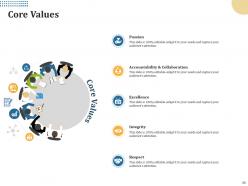Disaster management and communication to media powerpoint presentation slides
Establish the key actions to be followed while responding to any emergency situation with the help of Disaster Management And Communication To Media PowerPoint Presentation Slides. The presentation outlines the key objectives of the crisis plan to ensure that they are met. Discuss the types and levels of crisis by using disaster management ppt slideshow. Take advantage of our content-ready emergency management PowerPoint slide deck and highlight the methods used by the organization to deal with these threats. Make strategic decisions in order to reduce response time and provide guidance to the rest of the organization by taking the help of these crisis management planning PPT visuals. You can showcase the purpose of the crisis management plan such as to minimize losses, to undertake the rescue operations, to ensure the security and safety of staff and visitors, etc. The business continuity planning presentation allows you to highlight the steps to create a crisis management plan. Therefore, download our professionally designed contingency planning PowerPoint slide design and ensure that the organization is appropriately prepared for a crisis.
- Google Slides is a new FREE Presentation software from Google.
- All our content is 100% compatible with Google Slides.
- Just download our designs, and upload them to Google Slides and they will work automatically.
- Amaze your audience with SlideTeam and Google Slides.
-
Want Changes to This PPT Slide? Check out our Presentation Design Services
- WideScreen Aspect ratio is becoming a very popular format. When you download this product, the downloaded ZIP will contain this product in both standard and widescreen format.
-

- Some older products that we have may only be in standard format, but they can easily be converted to widescreen.
- To do this, please open the SlideTeam product in Powerpoint, and go to
- Design ( On the top bar) -> Page Setup -> and select "On-screen Show (16:9)” in the drop down for "Slides Sized for".
- The slide or theme will change to widescreen, and all graphics will adjust automatically. You can similarly convert our content to any other desired screen aspect ratio.
Compatible With Google Slides

Get This In WideScreen
You must be logged in to download this presentation.
PowerPoint presentation slides
Presenting Disaster Management And Communication To Media Powerpoint Presentation Slides. All templates are completely editable for your convenience. You can change the color, text, and font size of these slides. You can add or delete the content as per your requirement. Get access to this professionally designed complete deck presentation by clicking the download button below.
People who downloaded this PowerPoint presentation also viewed the following :
Content of this Powerpoint Presentation
Slide 1: This title slide introduces Disaster Management & Communication to Media. Add the name of your company here.
Slide 2: This slide contains the Table of Contents. This includes Introduction, Types & Levels of Crisis Identify Spokesperson, Crisis Directory, List of Emergency Personnel & Local Officials, Risk Assessment Crisis Inventory, Crisis Communication Control Centre- Equipment & Supplies, List of Key Publics & Key Media, Purpose & Objectives, Identify Crisis Management Team, Evaluation Form, Crisis Management Steps, Crisis Action Plan- Summary, Crisis Communication Policy, Social Media Responses, Press Release, Key Messages, and Communication Plan for Notifying Publics.
Slide 3: This slide presents the Introduction. This shows the key purpose of your company’s Crisis Management Plan and the person responsible for handling any crisis or disaster. This includes the the key priority of the company while handling any emergency/crisis/disaster is the safety of lives, property, community, and environment, and the main responsibility for effectively managing any crisis that might break out.
Slide 4: This presents the Purpose & Objectives. This outlines the key objectives of your Crisis Plan to ensure that they are met while dealing with any kind of crisis. This includes Safeguard human life and well-being, Preserve the natural environment, Minimize losses to property and other resources of the company, etc.
Slide 5: This slide presents the Types & Levels of Crisis. It identifies whether the crisis is limited or a major crisis. This includes Natural disasters, Technological Crisis, Confrontation Crisis, Crisis of Malevolence, Workplace Violence, and Rumors.
Slide 6: This presents part 1 of 2 of Identify Crisis Management Team. It includes the names, designation, and portfolio of each member.
Slide 7: This presents part 1 of 2 of Identify Crisis Management Team. It includes the names, designation, and portfolio of each member. A typical team composition Facility Management, Legal Department, Risk Management, Information Technology, etc.
Slide 8: This presents the Key Messages to be shared by the Spokesperson. When a crisis occurs, only the spokesperson is authorized to reveal information. This should be known to all employees in the organization.
Slide 9: This slide tabulates the Crisis Directory- Contact Chart in the event of a Crisis. Create the crisis communication team directory containing their names, designations, phone numbers, and email addresses for reaching them during crises.
Slide 10: This slide tabulates the List of Emergency Personnel & Local Officials. Prepare contact details of emergency contacts and authorities to quickly seek help such as the police department, fire department, and sales force, and more.
Slide 11: This presents part 1 of 2 of Risk Assessment. Each crisis should be rated on the "Likelihood" of the event occurring and the potential "Impact" it can have on the organization. Total score= Likelihood x Impact. Put them on the risk matrix to analyze priority concerns.
Slide 12: This presents part 1 of 2 of Risk Assessment. Here is another template to map the low-level, medium-level, and high-level risks.
Slide 13: This slide presents the Crisis Inventory- Ranking Based on Potential Occurrence. Be prepared for any crisis beforehand by anticipating the likelihood of occurrence of any adverse situations slide presents the Crisis Inventory- Ranking Based on Potential Occurrence.
Slide 14: This slide presents the Crisis Inventory- Ranking Based on Potential Damage to the Company. Also, prepare an inventory of risk based on the threat it poses to your company. Crisis response to the most damaging events should be planned in advance.
Slide 15: This slide presents the Crisis Communication Control Centre – Equipment & Supplies. List out the place where the crisis communication team will quickly meet to assess the situation. Ensure all equipment and supplies are available in the control center.
Slide 16: This slide presents Who are the publics that can be affected by any crisis? Prepare a list of media officials to reach out for conveying authentic information quickly. This includes Customers, Employees, Owners & Managers, Competitors, Vendors, and Safety Officials for the local television and local print media.
Slide 17: This presents part 1 of 2 of the Communication Plan for Notifying Publics. Identify your different categories of public and the communication channel for notifying them in the event of a crisis. These include email, dealership experience, local media, national media, internal emails, and social media.
Slide 18: PUBLICS This presents part 1 of 2 of the Communication Plan for Notifying Publics. Also, identify the team members responsible for communications and follow-up. These include email, telephone, personal visit, news release & fact sheet, and meetings.
Slide 19: This slide presents the Key Messages. Prepare messages to be released immediately after a crisis has occurred to show you are in control and avoid spreading any rumors.
Slide 20: This slide presents the Press Release Template. Create a standard template to be followed for writing a press release in advance to save time later. Some details include the Headline and Sub-Headline.
Slide 21: This slide showcases the Social Media Responses. Prepare key social media messages to quickly disseminate responses after the crisis and show your readiness, such as Apology and After Initial Crisis.
Slide 22: This slide presents the Crisis Communication Policy. The crisis communication policy guides the response of the organization and steps to be taken. This includes: Immediate reporting of all crises to a supervisor & the president & CEO; only the chief spokesperson and backup spokespeople are authorized to release information to the media and to the public, etc.
Slide 23: This slide tabulates the Crisis Action Plan- Summary. Have a one-page summary showing the best action for any kind of crisis. Separate the crisis by the level of risk and detail its description, team, and action.
Slide 24: This slide presents the Crisis Management Steps. When the crisis occurs, resort to a step-by-step approach to handle the situation effectively. This includes Safety, Notification, and Crisis Communication Team.
Slide 25: This slide continues the Crisis Management Steps from the previous slide. This includes Step 4- Assess the Situation: Describe the Situation, Immediate Steps to be Taken, Publics Affected, Key Message by Spokesperson, Communication Channels, and Media to be Contacted.
Slide 26: This slide continues the Crisis Management Steps from the previous slide: Develop Key Messages , Staff & Partner Notification, Record Keeping , and Post Crisis Review.
Slide 27: This slide presents the Evaluation Form for Post Crisis. Assess the effectiveness of the crisis communication plan by getting the survey answered. 1 strongly disagrees, 2 disagree, 3 neutral, 4 agree, and 5 strongly agree.
Slide 28: This slide introduces the Disaster Management & Communication to Media -Icons Slide for you to choose from.
Slide 29: This slide introduces Additional Slides.
Slide 30: This slide introduces the Agenda for a project or the company.
Slide 31: This slide introduces the Company Introduction. It includes the Background, Capabilities, Accreditation, Company’s Vision, and Company’s Mission.
Slide 32: This slide shows the members of the company team with their name, designation, and photo.
Slide 33: This slide provides the Vision and Mission for the entire company. This includes the vision, the mission, and the goal.
Slide 34: This slide presents Our Goals & Objectives. It includes Business Plan, Programmers for Strategic Objectives, Systems & Solutions, and Operation of Solution.
Slide 35: This slide provides the Core Values of the company. This includes, Passion, Integrity, Respect, Accountability & Collaboration, and Excellence.
Slide 36: This slide provides the Organizational Structure of the company. It shows areas such as client solutions, investment strategy, innovation& partnerships, and risk management.
Slide 37: This slide is a Timeline template to showcase the progress of the steps of a project with time.
Slide 38: This slide is a Roadmap template to showcase the stages of a project, for example.
Slide 39: This is a Thank You slide where details such as the address, contact number, email address are added.
Disaster management and communication to media powerpoint presentation slides with all 39 slides:
Use our Disaster Management And Communication To Media Powerpoint Presentation Slides to effectively help you save your valuable time. They are readymade to fit into any presentation structure.
-
Presentation Design is very nice, good work with the content as well.
-
Informative presentations that are easily editable.
-
Professional and unique presentations.
-
Nice and innovative design.
-
Nice and innovative design.
-
Awesome presentation, really professional and easy to edit.
-
Professional and unique presentations.
-
The Designed Graphic are very professional and classic.
-
Easily Understandable slides.


